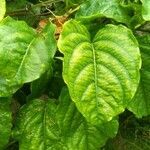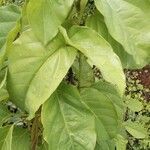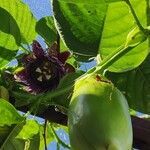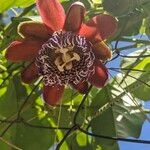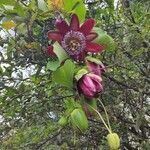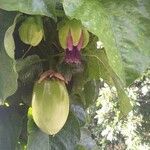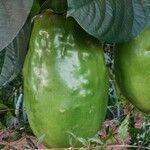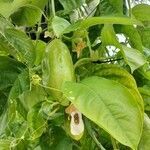Perennial liana to 15 m long, with simple axillary tendrils, glabrous. Stems 4-angular (the angles winged), stout. Stipules ovate or ovate-lanceolate, 2–4 cm long, 1–2 cm wide. Leaves alternate, simple; lamina ovate, 8–20 cm long, 7–15 cm wide, apex acute, base rounded to truncate, margin entire, without glands; petiole 2–7 cm long, with (2–) 6 (–8) large (1–2.5 mm diam.), mostly paired glands. Flowers bisexual, borne singly in leaf axils, (8–) 10–12 cm diam.; pedicels 1.5–4 (–5.3) cm long; bracts 3, ovate, (2–) 3–5.5 cm long, (1–) 2–4 cm wide, green, entire or serrate near base, glandular, free and cordate at base. Sepals white or pinkish adaxially, green abaxially, 3–4.7 cm long, not aristate. Petals pale purplish or red, 3–4.7 cm long. Corona of 5 or 6 series of filaments; outer 2 series white with reddish purple bands near base, white with purple bands toward apex, (4–) 6–7 cm long, wavy; inner series 1–4 mm long. Androgynophore 1.5–2.2 cm long, straight. Operculum white, reddish purple at margin, membranous, in 2 series, 4–6 mm long. Stamens 5. Styles 3. Fruit oblong-ovoid, 20–30 cm long, 10–15 cm wide, yellow or greenish yellow when mature, with a thick pericarp. Seeds reticulate in centre, radiately striate near margin.
Herbaceous vines, woody at base, 10-15 m long, glabrous. Young stem quadrangular, narrowly winged. Stipules ovate-lanceolate, 2-4 cm, margin entire, apex acute; petiole 3-5 cm, with 2 or 3 pairs of cupular glands; leaf blade broadly ovate to suborbicular, 7-13 × 5-15 cm, membranous, glabrous, lateral veins 8-12 pairs, tertiary veins somewhat prominent, base rounded to truncate, margin entire, apex acute. Inflorescence a reduced cyme, flower opposite tendril, tendril thick and strong; bracts leaflike, ovate, 3-5 cm, base cordate, apex acute. Pedicel 1-3 cm, triangular, articulate at middle. Flowers light red, 6-8(-10) cm in diam. Sepals green outside, red inside, ovate to ovate-oblong, 3-4 cm, sparsely pubescent. Petals light red, oblong to oblong-lanceolate, 2.5-3.5 cm. Corona in 5 series, white or purple, filamentous; outer 2 series 3-5 cm; middle series ca. 2 mm, capitate; inner 2 series 1-2 mm, threadlike, 4-5 mm, membranous, margin lacerate; operculum membranous, similar to fifth outer corona in shape; disk cupular. Stamens free. Ovary ovoid; styles purple; stigma 3-lobed. Berry yellow or orange at maturity, ovoid, 20-25 cm, rind thick and fleshy. Seeds many, 7-9 mm, flat. Fl. Feb-Aug.
Coarse climbers with prominently winged stems, glabrous throughout. Leaves petiolate, basifixed, entire, broadly ovate, abruptly and shortly acuminate, rounded at the base to broadly cordate, 10-20 cm. long, 8-15 cm. wide; petioles 2-5 cm. long, with about 3 pairs of ovoid glands; stipules foliaceous, ovate, acuminate, 2-4 cm. long. Inflorescences solitary, bearing a single greenish white flower flushed with rose or purple; peduncles 1.5-3.0 cm. long, jointed directly beneath the flower; bracts delicately foliaceous, broadly ovate, cordate, entire or essentially so, 2-4 cm. long and about as broad. Flowers about 8-12 cm. in diameter; sepals broadly oblong, conspicuously corniculate, 4-5 cm. long; petals ovate-lanceolate, 3-5 cm. long; filaments of the corona in 5 series, about equaling the petals. Fruits broadly oblongoid, up to 3 dm. long, pale yellow somewhat flushed with rose.
A long creeping vine with square stems. It has fleshy tuberous roots. The vine can be from 5-15 m long. The vine has four wings. The tendrils are pale green and coiled in a spiral. The tendrils are not branched and can be 30 cm long. The leaf stalk is 3 sided and 5-8 cm long. The leafy structures (stipules) at the base of the leaf are sword shaped and 2-5 cm long by 1-2.5 cm wide. The leaves are also large (10-25 cm long and 8-17 cm wide) and green or purple. The flowers occur singly in the axils of the leaves and can be 10-12 cm across. Flowers are white and purple and have red dots on them. The fruit is greenish yellow 12-30 cm long by 10-18 cm wide and with black seeds amongst purple flesh. The aril or layer around the seed is white and edible. The seeds are 1 cm long.
Leaf-lamina 10–20 × 8–15 cm., broadly ovate or ovate-oblong, abruptly acuminate at apex, entire-margined, rounded, subtruncate or shallowly cordate at the base, penninerved, the midrib prominent but more so beneath, the principal lateral nerves 10–12 on each side, prominent beneath; petiole 2–5 cm. long, stout, canaliculate above, with 3 pairs of nearly sessile glands; stipules 2–3·5 × 1–2 cm., ovate or ovate-lanceolate, acute at the apex, entire or slightly serrulate at the margin, narrowed at base, thinly membranous.
Corona in 5 rows, the 2 outer ones consisting of filaments as long as or exceeding the sepals, terete, radiate, banded with reddish-purple and white at base, blue at middle, densely mottled with pinkish-blue in the upper 1/2, the third row tubercular, the tubercles deep reddish-purple, the fourth row filamentose, the filaments 1–1·5 mm. long, banded with reddish-purple and white, the fifth row 3–7 mm. long, membranous, unequally lacerate.
Petioles 6-glandular; stipules (lanceolate-) ovate, more than 1 cm wide; flowers 7-10 cm ø, purple-red; corona filaments banded, purple-white; fruit 12-30 cm long, edible.
Calyx-tube campanulate; sepals 3–4 × 1·5–2·5 cm., ovate or ovate-oblong, concave, greenish or greenish-red outside, white, violet or pinkish inside.
Seeds 7–10 × 5–8·5 mm., broadly obcordate or suborbicular, flattened, reticulate at the centre of each face, striate at the margin.
Bracts 3–5·5 × 1·5–4 cm., cordate-ovate, acute, entire or serrulate towards the base, thin-membranous.
Petals 3–4·5 × 1–2 cm., oblong-ovate to oblong-lanceolate, obtuse, white or deeply pink-tinged.
Stem stout, 4-angled, the angles conspicuously winged; internodes 12 cm. long or more.
Operculum 4–6 mm. long, membranous, denticulate, white, reddish-purple at the margin.
Fruit 20–30 × 12–15 cm., oblong-ovoid, cylindrical or longitudinally 3-grooved.
Strong, herbaceous, glabrous plant climbing by tendrils.
Flowers solitary, 7·5–12·5 cm. in diam.
Peduncle 1·5–3 cm. long, 3-angled.
Limen annular, fleshy.
Tendrils stout.
Ovary ovoid.
